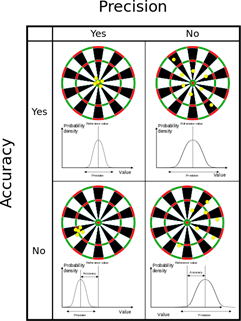
Knowledge and Skills Statement
The further explanation is designed to be a resource for educators that helps them better understand the topic their students are learning. Further explanations may be written at a more complex level than would be expected for students at the grade level.
Accuracy and precision are related concepts that are often confused. Accuracy and precision are both ways to measure data. Accuracy measures how close results are to the true or known value, often described by the percent error. Precision measures how close results are to one another, often measured by the standard deviation. Precision includes both repeatability and reproducibility. To make data repeatable, all variables, such as the instrument, operator, and environmental factors, are kept constant. For data to be reproducible, the same results must be obtained by different operators, on different instruments, and at different times. The image below shows the relationship between accuracy and precision.
Accuracy and precision combine to produce the margin of error (+/-). The accuracy and precision of data are often stated implicitly using significant figures. When the data are graphed, accuracy is seen in the amount of horizontal shift in the data, and precision is seen in the dispersion or spread of the data.
Research
Hunter-Thomson, Kristin. “Data Literacy 101: How Do We Set up Graphs in Science?” Science Scope 42, no. 2 (2018): 78–82. https://www.jstor.org/stable/26611838
Summary: Beginning with considering the type of data provided and the information needed to convey, "How Do We Set Up Graphs in Science?" shares how to determine appropriate graphs for communicating specific data with various audiences. A variety of graph types are explained, as well as the established criteria for each graph.

